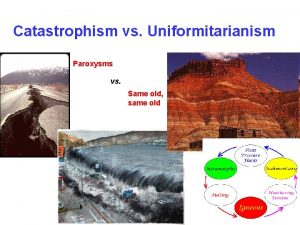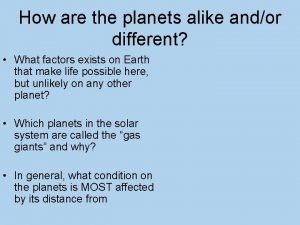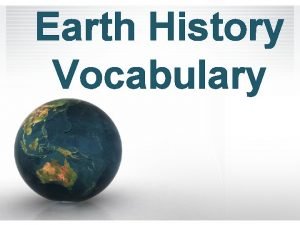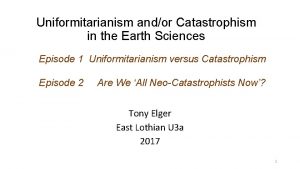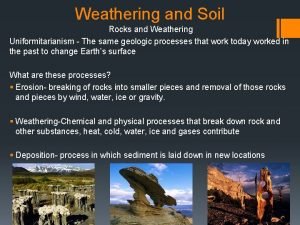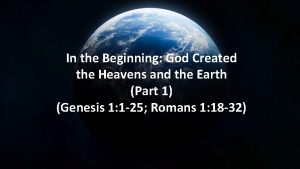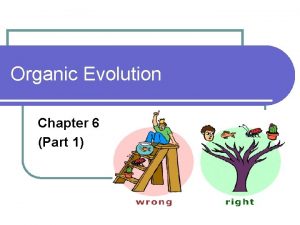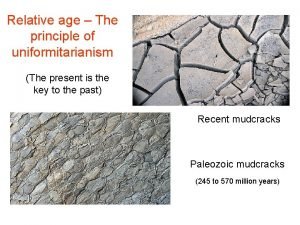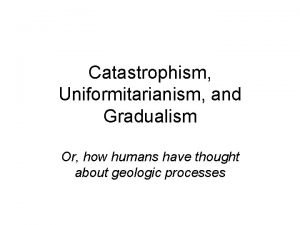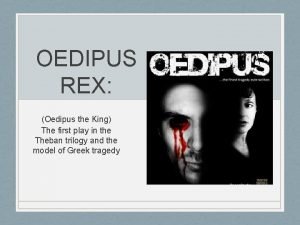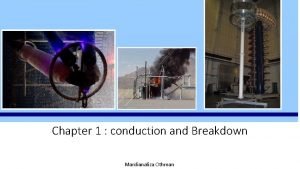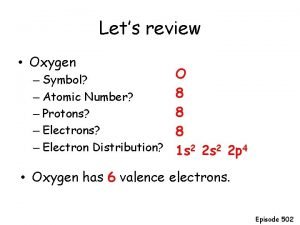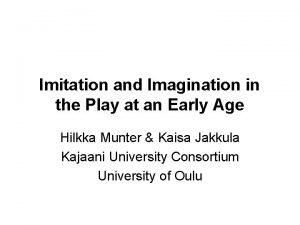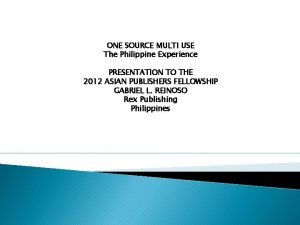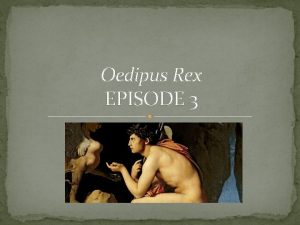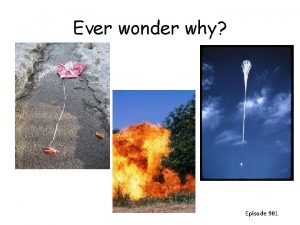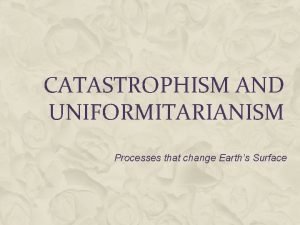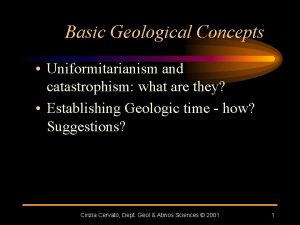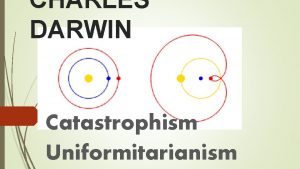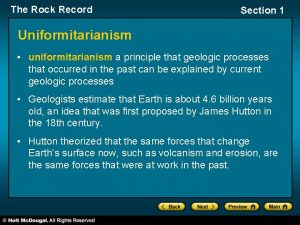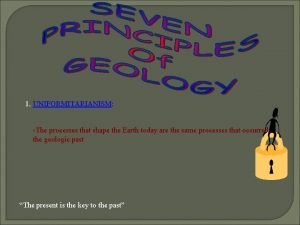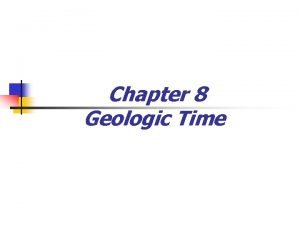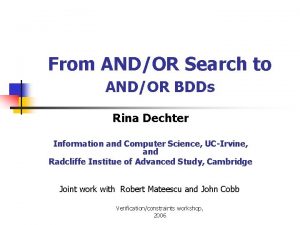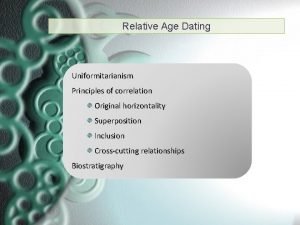Uniformitarianism andor Catastrophism in the Earth Sciences Episode































![Drop stones [and Brasier argues (against Parker), that eyes come later] Stromatolites Surface Ediacaran Drop stones [and Brasier argues (against Parker), that eyes come later] Stromatolites Surface Ediacaran](https://slidetodoc.com/presentation_image/3337718612cd69407290d919d7530252/image-32.jpg)












![Peter Schulte et al [39 other authors!] 2010 ‘Review: The Chicxulub Asteroid Impact and Peter Schulte et al [39 other authors!] 2010 ‘Review: The Chicxulub Asteroid Impact and](https://slidetodoc.com/presentation_image/3337718612cd69407290d919d7530252/image-45.jpg)
- Slides: 45

Uniformitarianism and/or Catastrophism in the Earth Sciences Episode 1 Uniformitarianism versus Catastrophism Episode 2 Are We ‘All Neo-Catastrophists Now’? Tony Elger East Lothian U 3 a 2017 1

Sequence of Presentation Introduction: Illustrations, Aphorisms and People Section 1 Charles Lyell’s Uniformitarianism and Stephen Gould’s Critique Section 2 Entrenched Uniformitarianism and the Return of Catastrophism: three case-studies • The case of the channelled scablands of Washington State • The case of the K-Pg mass extinction event • The case of the base-Cambrian circus of worms Section 3 Mapping different permutations of uniformitarianism and catastrophism Section 4 Conclusions: are we all neo-catastrophists now? 2

Introduction Debate between uniformitarians and catastrophists focuses on the Phanerozoic but also ranges across the whole of ‘deep time’ 3

Diagrammatic first approximations for uniformitarianism (left – the rock cycle) and catastrophism (right – a succession of mass extinctions) BUT earthquakes and volcanoes can be quite catastrophic BUT mass extinctions can accumulate over millions of years 4

Some aphorisms associated with uniformitarianism & catastrophism • ‘No vestige of a beginning, no prospect of an end’ (James Hutton Theory of the Earth 1788 final page) – cyclical, non-directional, ‘deep time’ model of earth processes • ‘The earth’s crust has been formed by causes now acting’ (Charles Lyell Principles of Geology 1830, p 39 in 1997 Penguin Classics edition) – often termed ‘actualism’ • ‘The present is the key to the past’ (Common modern paraphrase of Lyell) – ditto • ‘Palaeontologists cannot live by uniformitarianism alone’, in view of ‘the catastrophic nature of the stratigraphic record’ (Derek Ager The Nature of the Stratigraphic Record 1973 p 42) – what Ager (1923 -1993) termed ‘catastrophic uniformitarianism’ • ‘The present is not a master key to all past environments although it may open the door for a few’, so we must ‘develop non-actualistic models unlike any that exist today’ (Harold G. Reading (ed) Sedimentary Environments and Facies 1978 p 479) • ‘We must no longer expect to translate our modern world and its biology far backwards in time. The world before the Cambrian was more like a distant planet ’ (Martin Brasier Darwin’s Lost World 2009 p 177) – a non-actualistic directional model of earth processes • ‘We are all neo-catastrophists now’ (Jan Zalasiewicz, In Our Time, BBC Radio 30/1/14) 5

Some of the characters involved in the debates William Buckland 1784 -1856 Adam Sedgwick 1785 -1873 J Harlan Bretz 1882 -1981 Walter Alvarez 1940 - Charles Lyell 1797 -1875 William Whewell 1794 -1866 Charles Darwin 1809 -1882 Stephen J Gould 1941 -2002 Martin Brasier 1947 -2014 Jan Zalasiewicz 6

Section 1: Lyell and his critics Earth/rock cycle illustrating linked processes of rock formation, erosion, sedimentation and metamorphism discussed by Lyell 7

The classic argument of Charles Lyell (1797 -1875) • Lyell authored classic 3 volume text Principals of Geology (1830 -1833) subtitled ‘an attempt to explain the former changes of the earth’s surface by reference to causes now in operation’ – an approach that Whewell in an 1832 review named ‘uniformitarianism’ • In substantive terms Lyell highlighted the cumulative significance of small effects over very long periods of time and the cyclical rather than directional character of change • Within this framework he provided an unparalleled catalogue of the ‘variety, range, rate and extent of modern causes’ (Gould 1987: 128) available to explain the geological past • He also argued that apparent mass extinctions were artefacts of an incomplete fossil record, not the result of catastrophes • These arguments were constructed as a refutation of catastrophism, covering everything from biblical literalism (creation, flood) to widespread cataclysms and a cooling earth • Lyell also developed a distinctive statistical approach to fossil assemblages to map Tertiary stratification on a non-progressive basis (younger strata had lower % now extinct) • His arguments for uniformitarianism and gradualism became foundational for practicing geologists, as premises which allowed geological explanation to proceed 8

Charles Lyell at Glasgow Meeting of the BA 1840 (by Alexander Craig) The Temple of Serapis, the frontispiece of The Principles of Geology, is used to show the rise and fall of sea levels Pillars show episodes of subsidence, submergence and elevation 9

Gould’s critique of Lyell’s case for uniformitarianism • Lyell’s critique of catastrophism attacked a whole series of different positions which were all lumped together as fanciful invocations of unknown causes, but targets included the serious arguments of experienced field geologists (Agassiz, Cuvier, Buckland & Sedgwick) • Drawing particularly on Hooykaas (1905 -1994), Gould argued that Lyell’s powerful rhetoric slides between and conflates four distinct meanings of uniformitarianism: • 1. Uniformity of laws of nature across time and space • 2. Uniformity of geological processes (aka ‘actualism’) so that extinct causes should not be invoked if observable processes suffice • 3. Uniformity of rate, usually interpreted as dominance of small, steady, gradual processes over long periods (‘gradualism’) • 4. Uniformity of state (‘non-directionalism’) – change is continuous but limited and has a cyclical quality which leads nowhere • For Gould 1 & 2 are necessary methodological premises, but 3 & 4 are both testable and questionable substantive claims • Thus Gould (1987: 128) argued that ‘the real debate between Lyell and the [geologist] catastrophists was a complex argument of substance [about 3 & 4] among men who 10

De la Beche’s cartoon Stephen Jay Gould (1941 -2002) essayist, lampoons Lyell’s cyclical, nonprogressionist view of the palaeontologist, and history of life, a feature advocate of ‘punctuated highlighted by Gould equilibrium’ Gould’s Time’s Arrow, Time’s Cycle (1987) examined ideas of geological time in Burnet, Hutton and Lyell 11

Lyell’s cyclical view of life forms, lampooned here, is particularly distinctive and odd from a modern evolutionary viewpoint 12

Gould versus Secord in the debate about Lyell’s uniformitarianism • Secord argues that in Lyell’s published work Gould’s 3 and 4 were really parts of Lyell’s 2, namely methodological guidelines about observable rates and states that were consistent with actualism, rather than narrow substantive prescriptions • AND Secord emphasises that Lyell gave considerable attention to discrete local ‘catastrophes’, such as volcanism, earthquakes, tidal waves or floods, alongside a predominant emphasis on the power of small but cumulative changes • Gould recognises Lyell’s discussion of such dramatic local processes BUT argues that most uniformitarians have sought to minimise their scale and distinctiveness • BOTH Gould and Secord show that Lyell long embraced a strictly cyclical view of the history of the earth and of life, which explicitly rejected evolutionism and envisaged the possible re-emergence of extinct genera when the geological cycle returned to appropriate conditions • BUT they also stress that late in his career Lyell struggled with evidence of the progressive evolution of life (including Homo sapiens) which challenged this cyclical non -progressionism. For the natural history of life (only) he finally abandoned uniformity of state, and progressionism later became seen as integral to his gradualism 13

Modern cover depicting 1774 eruption of Vesuvius discussed by Lyell Sir Charles Lyell in his 70 s Darwin’s model of evolution belatedly accepted by Lyell 14

Section 2: Entrenched uniformitarianism versus neo-catastrophism Earthquake Tsunami Catastrophic Asteroid impact Diagrams chart the growth in use of catastrophe terms BUT also the limits of this trend 15

Entrenched uniformitarianism and the return of catastrophism: an introduction to the case-studies • Otto Schindewolf (1896 -1971) coined the term neo-catastrophism in 1963 BUT he was a maverick figure and (especially among Anglophone scientists) there was ‘still a strong inclination to dismiss any suggestion that there might ever have been “catastrophic” events of an intensity beyond any observed at the present day’ (Rudwick 2014: 267) • Uniformitarianism played a role in the rejection of ‘continental drift’ and in more specific arguments about local catastrophes, such as Bretz’s work on the ‘scablands’ (case 1) BUT new thinking about geological processes such as floods, tsunamis, turbidity currents and volcanism eventually extended the recognition of such regional catastrophes • Earth and planetary sciences had been linked in analyses of ice-ages, BUT geologists and physicists remained at odds about other potential links such as cosmic impacts (case 2). HOWEVER the resulting controversies have since brought recognition of broad-scale catastrophes AND stimulated efforts to integrate earth and astronomic processes • Re-examination of the fossil record alongside increasingly accurate absolute dating has prompted debate about ‘mass extinctions’ (case 2) and ‘explosive evolution’ across quite brief periods of deep time (case 3), in turn fuelling fresh consideration of major shifts in interlinked aspects of earth climate and ecology, such as snowball/slushball earth 16

Regional catastrophism? ‘Channelled scablands’ produced by ice melt and torrent from glacial lake Global catastrophism? Popular image of bolide based extinction of dinosaurs Distinct phases of progressive change? Illustrated by Tommotian small shelly fossils 17

Case 1: The case of the channelled scablands • J Harlen Bretz fieldwork in the ‘channelled scablands’ of east Washington State in 1920 s, investigated ‘coulee channels’, deep subparallel & anastomosing channels cutting through loess and underlying basalt, with hanging valleys, loess hills and basaltic stream gravel • In 1923 he interpreted this array of features as the product of a gigantic flood of glacial meltwater that covered thousands of square miles • In 1927 USGS and other geologists committed to ‘a priori gradualism’ (Gould 1980 quote) rejected this ‘diluvial’ account; stressed the role of long-run erosional processes of the Columbia river; and noted Bretz had not identified a source for any catastrophic flood • BUT existing research identified potential source in a huge glacial lake feature, Lake Missoula in Montana; Bretz (1969) later developed his account to chart eight huge flooding events; & 1970 s aerial survey showed massive stream bed ripples in gravel • By 1965 Bretz’s interpretation was recognised as correct and more widely relevant (‘we are now all catastrophists’) and in 1979 (aged 97) he was awarded GSA Penrose medal, while interest in the geology of the scablands (and Bretz’s work) continues to grow • Poses questions about what rates of change are incompatible with gradualism? Can 18 serial mini-catastrophes be consistent with substantive uniformitarianism?

J Harlen Bretz (18821981) in the field in Washington State Palouse Canyon showing channels created by massive torrents from glacial lake in Montana Large scale stream-bed ripples, diagnostic features of massive glacial meltwater floods 19

Plaque at the Dry Falls State Park Visitor Centre, Washington State, celebrating the work of J Harlen Bretz 20

Case 2: The case of the K-Pg mass extinction event • Palaeontologists had earlier mapped occurrence and debated scope and causes of ‘mass extinctions’, including major change in dominant taxa (and apparent demise of dinosaurs) toward the end of the Cretaceous (Cretaceous/Tertiary, now Paleogene, boundary) • In 1980 a team led by Luis and Walter Alvarez – physicist father and geologist son – found widespread iridium anomaly at K-Pg boundary; argued this was result of a massive extraterrestrial bolide impact; and saw this as likely cause of end Cretaceous mass extinction • Further research identified 180 km diameter impact crater at Chicxulub, Gulf of Mexico, as likely impact site, followed by spread of shock waves, atmospheric dust, prolonged darkness and climate change (with further indicators like shocked quartz at K-Pg boundary) • This sparked extensive interdisciplinary debate between impactors and critics, with sharp divide between different disciplines/specialisms with their distinctive expertise, models & biases (contrast approaches of e. g. planetary scientists and vertebrate palaeontologists) • Consequent interdisciplinary debate mainly between impactors & volcanists, with former conceding multiple impacts but still presuming extinction, and latter accepting impacts but often rejecting linkage with extinctions (with Deccan flood basalts as key alternative cause) 21 • ‘Heated’ public controversy has lasted 30+ years and generated much productive research

Luis Alvarez (1911 -1988) & Walter Alvarez (1940 - ) at the K-T boundary Iridium layer (Gubbio, Italy) which was linked with a bolide impact at the Chicxulub crater and the end Cretaceous mass extinction, prompting a major controversy documented by William Glen 22

Contrasting perspectives of ‘disciplinary aliens’: impactors versus volcanists (drawing primarily on William Glen ‘How Science Works in the Mass-Extinction Debates’, in Glenn (ed) 1994) • • • IMPACTORS Typically planetary geologists, cosmo- and geo-chemists and physicists (with a few micro-palaeontologists & punctuationists) Expertise in solar system, bolides and chemical signatures BUT often reliance on popular science accounts of extinctions Scientific protocols tended to emphasise precise calculation and predictive models despite uncertainties of the fossil record Catastrophic character of impacts, but based on uniformity of celestial & physical processes, with scope for periodic effects Original hypothesis modified to embrace multiple impacts and smearing of markers, to match extinction complexity • • • VOLCANISTS Typically geologists and palaeontologists (but varied by specialism, & volcanologists sceptical on both impacts and volcanism) Expertise in stratification, tectonics, fossils and extinctions BUT their critique often drew on popular science views of impacts Scientific protocols stressed complexity, with varied and uncertain outcomes, but also sought ‘increased stratigraphic detail’ Uniformitarian focus on known terrestrial processes but later allowed catastrophic character of very massive volcanism Later widespread acceptance of impacts but much continuing scepticism about both the timing and causes of extinctions 23

Arguments among palaeontologists about patterns of extinction David M. Raup (1933 -2015) highlighted the scope of extinctions at the big five major extinction episodes (below left) and mapped the relative frequency of more and less massive extinctions (below centre) Extinction episode Age, Myr before present Percent extinction Cretaceous (K–T/Pg) 65 76 Triassic 208 76 Permian 245 96 Devonian 367 82 Ordovician 439 85 BUT John C. Briggs, representing the many sceptics about impact, emphasised that such extinction events can be spread across several million years (ranging from <1 my for plankton, through 2. 5 my for marine biota, & 7 my for dinosaurs at K-Pg, to around 10 my for various taxa at the biggest, Permian-Triassic extinction) HOWEVER in Dinosaurs in a Haystack (1996) Gould reviews two key explorations of increased stratigraphic detail (meticulously “searching the haystack”) around the end of the Cretaceous, conducted by initially sceptical palaeontologists who eventually showed that the ammonites (studied by Peter Ward) and the dinosaurs (studied by Peter Sheehan) did die out quite sharply at the boundary: 24

Debates among planetary scientists about dynamics of bolide impacts • Planetary scientists (e. g. cosmochemists, comparative planetologists, exobiologists) agree bolide impacts are major influences on climates, geological processes and life/extinction on earth, and they often highlight the interplay of earth and planetary systems • BUT differences in approach range from concentration on the unique role of giant impacts, to modelling the varied impacts of multiple showers of big and smaller bolides (Victor Clube & William Napier call this ‘coherent catastrophism’), to accounts of the very complex ‘non-linear dynamics’ of interactions between earth and planetary processes • USGS cosmo-geologist Herbert Shaw (1930 -2002) pursued this complexity via analysis of multiple feedbacks between earth and solar systems, arguing e. g. that earth’s ‘geodetic keel’ steered spatial patterns of cratering which in turn influenced plate tectonics • Mike Davis (1998) notes such ‘anti-reductionist’, contingent accounts are difficult to test – especially when the crater catalogue is so incomplete; few tsunami markers of marine impacts have been identified; and human documentary sources are often ambiguous • BUT Davis agrees with Ursula Marvin: ‘impact is a geologic process of major importance which by its very nature demolishes uniformitarianism as the basic principle of geology’ [it is thus] ‘a far more revolutionary departure from classical geology than plate tectonics’ 25

The K-Pg Boundary: Continuing controversy and its possible resolution • Criteria for mass extinctions: what proportion of extinctions within what time frame? NB extinctions vary in their range across time and taxa; they may be artefacts of incomplete or under-sampled fossil records; or be masked by the reworking of earlier fossil material • Causal mechanisms conducive to mass extinctions: are bolide impacts (and craters) timely and sufficient to produce documented extinctions? Are volcanism (and flood basalts) timely and sufficient? Might the causes or impacts of such processes be linked? • Issue of similarities and differences between key mass extinctions: can we generalise from the K-Pg events or were different mechanisms involved elsewhere? • Regarding Chicxulub and a K-Pg extinction, a thorough review (Peter Shulte + 39 others 2010) found all the following fitted & reinforced the modified Alvarez hypothesis: (i) timing of the impact and the Iridium anomaly; (ii) geographic spread of a predictably varied impact signature and climate indicators; and (iii) taxonomic pattern of extinctions • BUT Gerta Keller (2005, 2017) reminds us that longer term volcanism may have stressed the biota before the impact AND impacts may not explain other mass extinctions • Two key implications for uniformitarianism: rare but massive events can play a key role in earth history and astronomical influences may intrude on earth history 26

Case 3: The case of the Cambrian circus of worms • Case 3 shifts discussion from specific catastrophes to issue of how changes in prevailing conditions and dominant ecologies across deep time may challenge uniformitarian assumptions of continuity – and therefore actualism as a heuristic approach • Such changes might involve levels of bombardment, distinctive temperature regimes, the chemistry of oceans or atmosphere, continental configurations or distinctive ecologies • This issue becomes more acute the further we go back in deep time so here I focus on debate about the distinctive conditions and ecologies typifying key phases of the Precambrian and Cambrian periods • Many recent researchers have debated those features which have marked the evolution of life across these periods, but I draw particularly on a recent and wide-ranging overview of the distinctiveness of Precambrian and Cambrian fossils and ecologies by Martin Brasier, in Darwin’s Lost World: The hidden history of animal life (2009) • Brasier chaired the ICS panel investigating/defining the Cambrian-Precambrian boundary; he offers an accessible account of sites, researchers, rivalries, debates & findings involved; & he locates the type locality for this boundary (showing trace fossils of a bioturbating ‘circus of worms’) at Fortune Head, Newfoundland 27

Martin Brasier (1947 -2014) was a key explorer of the ‘lost world’ of Cambrian and Precambrian fossils and reconstructed the ‘circus of worms’ marking the ‘Cambrian explosion’ 28

Diagram from Aodhán Butler (2015) * * Further localities visited and discussed by Brasier and/or Conway Morris Sirius Passet, Greenland Wangjiawan, China Ulakhan-Sulugur, Siberia Gobi-Altai, Outer Mongolia Fortune Head, Newfoundland Mistaken Point, Newfoundland Doushantuo, South China, 580 Gubrah Bowl, Oman, 716 29

Brasier’s argument about the Cambrian boundary and ‘explosion’ • He identifies three ways of addressing key puzzles about this ‘lost world’, including the rarity of fossils before the Cambrian ‘explosion’ & the absence of a shelly fauna in the Precambrian • 1 Charles Lyell’s Hunch, poor fossil record but still likely that known genera will be found in ancient sediments: good heuristic BUT less so as wide exploration shows good preservation • 2 Reginald Daly’s Ploy, dramatic changes in ocean chemistry (e. g. carbonate or oxygen levels) explain patterns of fossilisation BUT changes rarely match patterns of fossilisation • 3 William Sollas’s Gambit: internal evolutionary trend, from shell-less to thin then thicker shells BUT what explains this: genetic drift or some other driver? • For us Brasier’s crucial argument is that it is misleading to rely on a uniformitarian reading of Precambrian fossils and ecologies based on living analogues because forms of life & whole ecologies have radically changed • So he highlights a directional reading of the fossil record and environment, where the dynamics of ecological changes are critical e. g. rise of predators stimulates shell making & burrowing, in turn transforming chemistry of seafloor (& diminishing scope for fossilisation) 30

Key features of the argument about the Cambrian ‘circus of worms’ Reconstruction of ‘circus of worms’ (and early trilobite) on basis of trace fossils characterising earliest Cambrian, when burrowing (hence bioturbation) and shelly bodies originated Maps sequence of changes in ‘top soil’ of seafloor through Ediacaran and into Cambrian ‘Terrors with teeth’ may have influenced emergence of burrowing and hard shells (fossil phosphatic spines envisaged as parts of feeding apparatus of predatory penis worm) 31
![Drop stones and Brasier argues against Parker that eyes come later Stromatolites Surface Ediacaran Drop stones [and Brasier argues (against Parker), that eyes come later] Stromatolites Surface Ediacaran](https://slidetodoc.com/presentation_image/3337718612cd69407290d919d7530252/image-32.jpg)
Drop stones [and Brasier argues (against Parker), that eyes come later] Stromatolites Surface Ediacaran fauna Beginnings of bioturbation Extensive burrowing and shelly fauna 32

Section 3 Varieties of uniformitarianism and catastrophism Part I Introduction Chapter 1: What is a Catastrophe? Chapter 2: What is Catastrophism? Part II The Rise and Fall of Catastrophism Chapter 3: Non-actualistic Catastrophism and the Inorganic World Chapter 4: Actualistic Catastrophism and the Inorganic World Chapter 5: Gradual Change and the Inorganic World Chapter 6: Catastrophes, Gradual Change and the Organic World Part III The Revival of Catastrophism Chapter 7: Inorganic History Chapter 8: Organic History Chapter 9: Synthesis 33

Mapping different permutations of uniformitarianism and catastrophism • In his book on Catastrophism Richard Huggett uses four key distinctions to map a wide range of different positions on changing forms, rates and states of geological processes both in the history of earth science and in current theorising • First Gould’s 2: Actualism argues that processes that can be observed operating now exhaust the range of possible processes, while non-actualism suggests that other processes (here excluding mystical ones) may have operated in the past (consider cases 2 & 3) • BUT Huggett also notes that the boundary between actualism and non-actualism can be contested: does actualism merely invoke the general physics of e. g. erosion by water or is it limited to rates of erosion that are currently observed? (consider case 1) • Second Gould’s 3: Model of a steady (and usually gradual) rate versus model of a variable (and sometimes rapid) rate of change • Third Gould’s 4: Model of a steady state (possibly with cyclical features) versus model of a changing state (often identified as directional or even progressionist) • Finally Huggett also highlights a further distinction, specific to analyses of the history of life forms, by contrasting environmental and internalist explanations for the history of these forms (what Brasier in case 3 termed ‘Daly’s ploy’ vs ‘Sollas’s gambit’) 34

A flavour of different permutations of uniformity and catastrophe in inorganic earth history, with named historical and recent exponents X Actualism versus Nonactualism Steady state (Non-directionalism) Constant rate (Gradualism) Actualist non-directional gradualism Actualist directional gradualism (Most of Hutton, Playfair, Lyell, Hack on (Some Hutton, Darwin, Holmes et al on plate landscape dynamic equilibrium) tectonics, H. Owen on expanding earth) Changing rate (Catastrophism) Changing state (Directionalism) Non-actualist non-directional gradualism (Carpenter) Non-actualist directional gradualism (de Maillet, Buffon, possibly Wegener on drift, Cayeau on sedimentation) Actualist non-directional catastrophism (Hall, Bretz? Nance on ‘supercontinent cycles’) Actualist directional catastrophism (Steno, Werner, de Beaumont, Warlow on fast pole shift, Alvarez et al on bombardment, Loper et al on periodicity of core-mantle coupling, Ollier’s ‘evolutionary geomorphology’) Non-actualist non-directional catastrophism (Bonnet, Cuvier) Non-actualist directional catastrophism (diluvialists, scriptural geologists, Velikovsky, Clube et al on cyclical bombardment) 35

A flavour of different permutations of uniformity and catastrophe in organic earth history, with named historical and recent exponents X Externalist vs Internalist Steady state (Non-directionalism) Changing state (Directionalism) Constant rate (Gradualism) Environmentalist/ externalist nondirectional gradualism (Hutton, most of Lyell) Environmentalist/ externalist directional gradualism (Chambers, Darwin, very late Lyell, Darwinian ‘modern synthesis’, creeping mass extinctions linked to palaeogeographic change) Internalist non-directional gradualism (Lamarck) Internalist directional gradualism (Erasmus Darwin, Schindewolf’s ‘orthogenetic evolutionism’) Changing rate (Catastrophism) Environmentalist/ externalist nondirectional catastrophism (Cuvier, Thompson) Internalist non-directional catastrophism (very late Agassiz) Environmentalist/ externalist directional catastrophism (Bonnet, late Buckland, theorists of ‘rapid speciation’, Gould et al on ‘punctuated equilibrium’, rapid mass extinctions linked to cosmic processes) Internalist directional catastrophism (most of Agassiz, Oken, Goldscmidt’s ‘hopeful monsters’, aspects of Gould and Brasier) 36

Huggett’s depictions of patterns and dynamics of earth processes Cyclical Episodic Periodic Sporadic Different styles or rhythms of geological change, highlighted by my adaptation of his terms Schematic diagram of core-mantle coupling from Courtillot and Besse (1987), illustrating interplay of gradual but cumulative processes and sudden processes (such as magnetic reversal) 37

Huggett’s depiction of key phases in the directional character of geological change Table of major changes in key features of the earth and its bio-sphere, suggesting profound shifts in the geological processes involved over deep time. This suggests the limitations of actualism and the need for analysis of each earlier phase in non-actualistic terms 38

Key themes in Huggett’s overview of uniformitarianism & catastrophism • Huggett’s intellectual history documents the rich variety of different arguments and positions that have been espoused in analyses of rates and states of geological processes, often hidden beneath the general contrast between uniformitarianism and catastrophism • He also distinguishes between periodic and episodic versions of both gradualism and catastrophism, which might be more clearly labelled cyclical vs episodic gradualism and periodic vs spasmodic catastrophism • His history outlines positions irrespective of their current acceptability BUT he also offers a critical appraisal of their claims, dismissing some variants of catastrophism (such as Velikovsky) but supporting others (especially cosmic processes like bolide impacts) • Consequently uniformitarianism is too narrow as a template for geological analysis – gradual and cyclical processes are widespread, but arguments about their significance must be defended on their merits alongside the assessment of more disruptive processes, (& recognition of the interplay of gradual & rapid processes in non-linear dynamic systems) • His substantive appraisal also demonstrates that major changes in earth processes (of e. g. bombardment, atmosphere, plate tectonics, orogeny, erosion, sedimentation, life forms) undermine any narrow actualism, and require periodised analyses of ‘system dynamics’ 39

Conclusions First just a reminder that detailed fieldwork underpins the arguments over catastrophism 40

Concluding Themes • Uniformitarian arguments highlight the scope for gradual processes to create large effects over deep time and offer a valuable heuristic for much geological explanation in terms of observed states and rates • BUT dogmatic appeals to uniformity are dangerous as they obscure the role of local, regional or even global catastrophic (sudden, rapid or cascading) processes which meet criteria of scientific reasoning and testability (including some form of observability) • AND in contrast to narrow actualism, we must recognise that physical and biological processes may operate in very different ways in different eons or even in shorter periods of deep time, meaning they are not directly observable as current processes • THUS labels like uniformitarianism cannot simply be extended at will and cannot substitute for careful assessments of the specific theories and substantive findings involved in analysing and explaining geological processes and formations • SO perhaps we need a critical synthesis of neo-uniformitarianism and neocatastrophism which recognises the wide range of possibilities covered by each of these terms, and the scope for complex combinations and sequences of the processes they highlight (this is perhaps the implication of Huggett’s discussion of ‘non-linear processes’, ‘chaos theory’ and ‘emergent properties’) 41

Coda • On actualism: “The present can instruct us about the past, and I think the past can instruct us about the present, but we should be alert to what may be exclusive to one or the other” (William Glen [ed] The Mass Extinction Debates 1994 p 286) • On gradualism: “Increasingly, rare and large-scale events and their driving forces are being added to the repertoire acceptable to uniformitarianists” (Glen 1994 p 286) • On combining uniformitarianism and catastrophism: “The history of any one part of the earth, like the life of a soldier, consists of long periods of boredom [uniformity] and short periods of terror [catastrophe]” (Derek Ager The Nature of the Stratigraphic Record 1973 p 141) • On the limits of uniformitarianism: “If these mass extinctions are real, they must have been caused by forces acting outside (or at the far extreme range of) typical uniformitarian processes, and over a timescale measurable in ecological rather than geological time” (Keith Thompson Fossils: A very short introduction 2005 p 96) • So we could ask, how far can neo-uniformitarianism be stretched before it is undermined (or subsumed) by neo-catastrophism? (remember Marvin’s strong claim that “bolide impact is a geological process of major importance, which by its very nature, demolishes uniformitarianism itself as the basic principle of geology”) 42

References {Derek Ager 1973/1993 The Nature of the Stratigraphical Record Macmillan} {Derek Ager 1993/1997 The New Catastrophism: the Impact of Rare Events in Geological History CUP} Martin Brasier 2009 Darwin’s Lost World: The hidden history of animal life OUP J Harlan Bretz 1969 ‘The Lake Missoula floods and the channelled scablands’ Journal of Geology 77: 505 -543 Elisabeth Clements 1994 ‘The Impact Hypothesis and Popular Science: Interdisciplinary Debate’ in Glenn (ed) 1994 a {Vincent Courtillot and Jean Besse 1987 ‘Magnetic Field Reversals, Polar Wander, and Core-Mantle Coupling’ Science 237: 11401147} Mike Davis 1996 ‘Cosmic Dancers on History’s Stage? The Permanent Revolution in the Earth Sciences’ New Left Review I/217 48 -84 William Glenn (ed) 1994 a The Mass-Extinction Debates: How science works in a crisis Stanford UP William Glenn 1994 b ‘What the Impact/Volcanism/Mass-Extinction Debates are About’ in Glenn (ed) 1994 a William Glenn 1994 c ‘How Science Works in the Mass-Extinction Debates’ in Glenn (ed) 1994 a {Stephen Jay Gould 1965 ‘Is uniformitarianism necessary? ’ American Journal of Science 263: 223 -228} Stephen Jay Gould 1978 ‘Uniformity and Catastrophe’ and ‘Velikovsky in Collision’ in Ever Since Darwin 147 -159 Stephen Jay Gould 1980 ‘Return of the Hopeful Monster’ and ‘The Great Scablands Debate’, in The Panda’s Thumb, Penguin, 155 -169 Stephen Jay Gould 1996 ‘Dinosaur in a Haystack’, pp 147 -158 in Dinosaur in a Haystack, Penguin Stephen Jay Gould 1987 Time’s Arrow, Time’s Cycle: Myth and Metaphor in the Discovery of Geological Time Penguin 43

Richard Huggett 1997 Catastrophism: Asteroids, Comets, and Other Dynamic Events in Earth History (2 nd ed) Verso {David Jablonski 1991 ‘Extinctions: A Paleontological Perspective’ Science 235: 754 -757} Gerda Keller 2005 ‘Impacts, Volcanism and Mass Extinction: random coincidence or cause and effect? ’ Australian Journal of Earth Sciences 52: 725 -757 Charles Lyell 1830 -33/1997 Principles of Geology (selected text, edited with an ‘Introduction’ by James Secord) Penguin Nick Marriner, Christophe Morhange and Stefan Skrimshire 2010 ‘Geoscience meets the four horsemen? Tracking the rise of neocatastrophism’ Global and Planetary Change 74: 43 -48 Angela C. Milner (1998) ‘Timing and causes of vertebrate extinction at the K/T boundary’, in M. Grady et al (eds) Meteorites: Flux with Time and Impact Effects Geological Society Special Publications 140, 247 -257 Simon Conway Morris 1998 The Crucible of Creation: The Burgess Shale and the Future of Life OUP esp chapter 1 David M. Raup 1994 a ‘The Extinction Debates: A View From the Trenches’ in Glenn (ed) 1994 a David M. Raup 1994 b ‘The Role of Extinction in Evolution’ Proceedings of National Academy of Science 91: 6758 -6763 {Harold G Reading (ed) 1978/1996 Sedimentary Environments and Facies Blackwell} Martin J S Rudwick 1975 ‘Caricature as a Source for the History of Science: De la Beche’s anti-Lyellian Sketches of 1831’ Isis 66: 534 -560 Martin J S Rudwick 2014 Earth’s Deep History: How it was discovered and why it matters, esp chapter 11, ‘One Planet among Many’ University of Chicago Press {Herbert Shaw 1994 Craters, Cosmos and Chronicles: A New Theory of Earth Stanford University Press} 44
![Peter Schulte et al 39 other authors 2010 Review The Chicxulub Asteroid Impact and Peter Schulte et al [39 other authors!] 2010 ‘Review: The Chicxulub Asteroid Impact and](https://slidetodoc.com/presentation_image/3337718612cd69407290d919d7530252/image-45.jpg)
Peter Schulte et al [39 other authors!] 2010 ‘Review: The Chicxulub Asteroid Impact and Mass Extinction at the Cretaceous-Paleogene Boundary’ Science 327: 1214 -1218 {John Soennichsen 2009 Bretz’s Flood: The Remarkable Story of a Rebel Geologist & the World’s Greatest Flood Sasquach} Keith Thompson 2005 Fossils: A Very Short Introduction Oxford University Press, esp. chapter 7 Web and iplayer sources ‘Derek Ager Quotations’ accessed 4/8/2017 from Today in Science History web-site https: //todayinsci. com/A/Ager_Derek_Quotations. htm Aodhán Butler 2015 ‘Fossil Focus: The place of Small Shelly Fossils in the Cambrian Explosion, and the Origins of Animals’ www. palaeontologyonline. com vol 5 article 7 pp 1 -14 Ben Garrod & Alice Roberts 2017 ‘The Day the Dinosaurs Died’ BBC 2 15 th May (available on BBC TV i-player) Sören Jensen 2004 ‘Into Focus: The Never-Ageing Ager’ Palaeontologia Electronica 7. 1 3 pp http: //palaeoelectronica. org/palaeo/loc. htm Gerta Keller accessed 18/9/2017 ‘Volcanism, Impact and Mass Extinction’ https: //gkeller. Princeton. edu/ Andrew Scott, Jan Zalasiewicz and Leucha Veneer 2014 ‘Catastrophism’, BBC In Our Time broadcast 30/1/14 (available on BBC radio i-player) John Soennichsen 2009 ‘Legacy: J Harlen Bretz (1882 -1981)’ University of Chicago Magazine uchicago-magazine@ uchicago. edu Cassandra Tate 2007 ‘Bretz, J Harlan (1882 -1981) Geologist’ Historylink. org Essay 8382 www. historylink. org/File/8382 Wikipedia web-pages for Agassiz, L & W Alvarez, Bretz, Buckland, Cuvier, Gould, Keller, Lyell, Raup, Sedgwick and Whewell 45
 Princlble
Princlble Hutton's principle of uniformitarianism
Hutton's principle of uniformitarianism Human sciences tok definition
Human sciences tok definition How are the inner and outer planets alike?
How are the inner and outer planets alike? Andor györgy üzleti gazdaságtan
Andor györgy üzleti gazdaságtan Andor matlab
Andor matlab Andor logic
Andor logic Andor györgy üzleti gazdaságtan
Andor györgy üzleti gazdaságtan Andor györgy üzleti gazdaságtan
Andor györgy üzleti gazdaságtan Andor insert
Andor insert Andor györgy
Andor györgy Andor basic
Andor basic Python jumpstart
Python jumpstart Whats uniformitarianism
Whats uniformitarianism Uniformitarianism drawing
Uniformitarianism drawing How does temperature break down rocks
How does temperature break down rocks Uniformitarianism
Uniformitarianism Uniformitarianism examples
Uniformitarianism examples Conformity
Conformity Uniformitarianism vs gradualism
Uniformitarianism vs gradualism Where was oedipus born
Where was oedipus born Othman episode 1
Othman episode 1 Geiteams
Geiteams Highway patrol episode fake cop
Highway patrol episode fake cop Oxygen symbol
Oxygen symbol Divine intervention biostats
Divine intervention biostats Nonlinguistic representations examples
Nonlinguistic representations examples Verbal irony in serial episode 3
Verbal irony in serial episode 3 Imitation episode 2
Imitation episode 2 Panday (2005 tv series)
Panday (2005 tv series) Praying at the gates
Praying at the gates Oedipus rex scene 3 summary
Oedipus rex scene 3 summary First episode psychosis
First episode psychosis La catrina episode 1
La catrina episode 1 Single episode
Single episode La catrina episode 13
La catrina episode 13 Econmovies episode 5 worksheet answers
Econmovies episode 5 worksheet answers Plot for flowers for algernon
Plot for flowers for algernon Influenced episode 2
Influenced episode 2 Econmovies episode 5 cars
Econmovies episode 5 cars Liberty the american revolution episode 3
Liberty the american revolution episode 3 Happy monday answer key
Happy monday answer key Muse 2 episode 2: every behavior meets a need
Muse 2 episode 2: every behavior meets a need Food inspectors series 2 episode 2
Food inspectors series 2 episode 2 Episode 901 review answers
Episode 901 review answers Mypods and boomsticks full episode
Mypods and boomsticks full episode
